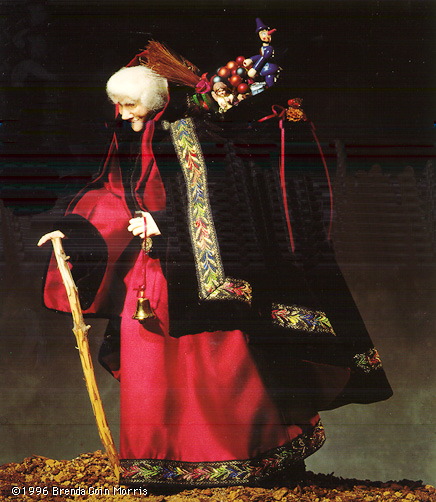
Italian traditions in Italy are based heavily on the religion of Christianity. Christmas starts eight days before Christmas and lasts till after the Feast of Epiphany.

La Befana vien di notte
Con le scarpe tutte rotte,
Col vestito alla romana,
Viva, viva la Befana!
(The Befana comes at night
With her shoes all broken,
With a Roman-style dress,
Hurray, hurray for the Befana!)
The name "Befana" must take its origin from a corruption of the word "Epifania" - Epiphany - but somehow has come to mean an ugly old witch. On January 5, eve of the Epiphany, she flies around on her broomstick delivering sweets to the good children and lumps of coal to the bad ones: they find them by their beds when they wake up in the morning on January 6. (As there are no bad children nowadays - or perhaps because coal fires are no longer in use - a black sweet takes the place of real coal.)
But the real meaning of Epiphany is still celebrated on January 6, which is a national holiday in Italy and a feastday of the Catholic church. There are processions in many towns, where people act out the arrival of the Three Wise Men at the stable in Bethlehem.
Children in Italy hang up their stockings on the Feast of the Epiphany, January 6. They celebrate the visit of the Three Kings to Bethlehem. Instead of Santa Claus, children are expecting Befana. She is a witch-like character who rides around on a broom.
The legend is that the Three Wise Men stopped at Befana's hut to ask directions on their way to Bethlehem and asked her to join them. She said no, she was too busy. Later a shepherd asked her to join him in paying respect to the Baby Jesus. Again, Befana said no. Later when it was dark and she saw a great light in the skies, she thought perhaps she should have gone with the Wise Men. So, she gathered some toys that had belonged to her own baby, who had died, and ran to find the kings and the shepherd. But Befana could not find them or the stable. Now, each year she looks for the Christ Child. And each year since she can not find him, she leaves the gifts for the good children of Italy and pieces of charcoal for the bad ones. MAX says that after that a spell was cast on her to be forever ugly, only through the good deeds for children can she become beautiful again.
The Befana is an old person who comes down the chimney and fills up stockings with nuts and fruit and brings presents for all the good children. The children write notes and hide them up the chimney for the Befana The notes are generally a list of the toys that they want the Befana to bring. The whole town is in a state of great anticipation the day the Befana is due. After the arrival many parties take place, people move around from house to house visiting friends and relations and the day after many people wish they hadn't celebrated quite so much. For many people reading this for the first time they must already have an image in their head of a jolly smiling old man with a white beard and a red coat.... Fafher Christmas, instead the Befana is something completely different:
The Befana arrives on the 5th January, the day before Epifania.
The Befana is generally dressed in black.
Last but not least,
The Befana is an old and very ugly woman.